Messerschmitt
Me 262 B-1a/U1

Airfix, 1/72 scale
S
u m m a r y : |
Description and Item No.: |
Airfix Kit No. A04062 - Messerschmitt Me 262 B-1a/U1 |
Contents and Media: |
65 parts in grey plastic (some parts not used), 3 clear parts, one decal sheet with markings for 2 aircraft. |
Price: |
£18.99 EU Price (£15.83 Export) plus shipping from Hannants
USD $27.02 plus shipping from HobbyLink Japan |
Scale: |
1/72 |
Review Type: |
First Look |
Advantages: |
This is a nicely detailed, new mold Me 262 B with simple engineering and nice surface details that will provide an easy, straightforward build. |
Disadvantages: |
Some recessed details are heavy. Likewise some of the surface details, provided in relief, are a bit rudimentary. The kit utilizes a cumbersome pitot tube assembly. |
Recommendation: |
The engineering on this kit is simple and straightforward. The decals provide markings for two interesting, lesser-known airframes. |
Reviewed by John Miller

Airfix's 1/72 scale Sea King is available online from Squadron.com
The Messerschmitt Me-262, Schwalbe (Swallow) in fighter versions, or Sturmvogel (Storm Bird) in fighter-bomber versions, was the world's first operational jet-powered fighter aircraft. Design work started before World War II began, but problems with the engines, metallurgy, and top-level interference kept the aircraft from becoming operational until mid-1944.
The Schwalbe was faster and more heavily armed than any Allied fighter, including the British jet-powered Gloster Meteor. In addition to being one of the most advanced operational aviation designs of World War II, the aircraft was also versatile being modified for use as a light bomber, reconnaissance, and experimental night fighter version.
In total Me-262 pilots claimed 542 Allied aircraft shot down, although higher claims are sometimes made. The Allies countered its effectiveness in the air by attacking the aircraft on the ground and during takeoff and landing. Engine reliability problems, from the pioneering nature of its Junkers Jumo 004 axial-flow turbojet engines—the first ever placed in mass production—and attacks by Allied forces on fuel supplies during the deteriorating late-war situation also reduced the effectiveness of the aircraft. As a consequence, the Me-262 had a negligible impact on the course of the European air war.
Several two-seat trainer variants of the Me 262, the Me 262 B-1a, had been adapted through the Umrüst-Bausatz 1 factory refit package as night fighters, complete with on-board FuG 218 Neptun high-VHF band radar, using Hirschgeweih ("stag's antlers") antennae with a set of dipole elements shorter than the Lichtenstein SN-2 had used, as the B-1a/U1 version. Serving with 10. Staffel Nachtjagdgeschwader 11, near Berlin, these few aircraft (alongside several single-seat examples) accounted for most of the 13 Mosquitoes lost over Berlin in the first three months of 1945. Intercepts were generally or entirely made using Wilde Sau methods, rather than AI radar-controlled interception.
While German use of the aircraft ended with the close of World War II, a small number were operated by the Czechoslovakian Air Force until 1951. In addition, captured Me-262s were studied and flight-tested by the major powers ultimately influencing the designs of a number of post-war aircraft including the North American F-86 Sabre and Boeing B-47 Stratojet.
The blue-grey styrene parts are arranged on three sprues and the plastic is slightly soft and easy to work with. There is little-to-no flash on any of the parts and the surface texture is very smooth.
The recessed details are very well done if not a bit on the heavy side along some lines. In addition, Airfix opted to make some access panels out-scribed or in relief.
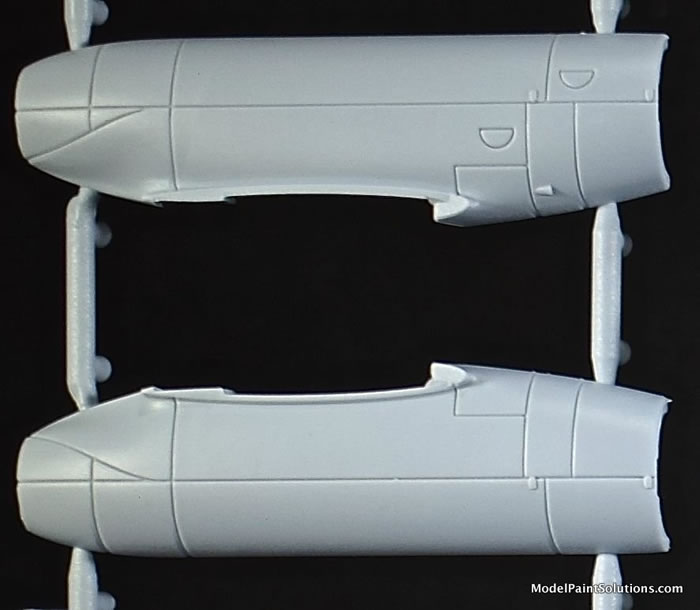
Assembly is conventional and starts with the cockpit wherein there is some very nice engineering. The cockpit assembly is enclosed in a detailed tub the exterior of which is visible through the main wheel wells just as with the 1/1 version: very nice. Likewise, appropriate bulkheads fore and aft of the main wheel wells are provided which will close off the wells nicely and accurately.
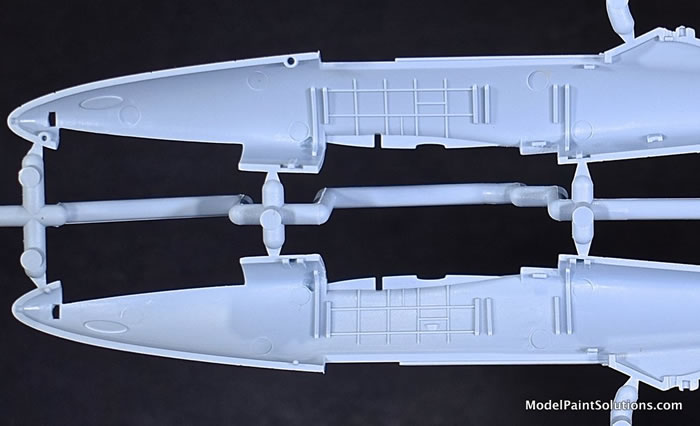
The nose wheel well is part of the ventral nose section and is very nicely detailed. This arrangement will also facilitate the placement of nose weight (suggested 5 grams).
The engine nacelles feature well-detailed intakes and exhausts that are seamless: much appreciated Airfix. As with the rest of the kit, the parts count is low with just 7 parts per nacelle.
The single piece horizontal stabilizers are well detailed with unposeable elevators. Likewise the single piece rudder is nicely detailed with appropriately thin trailing edges.
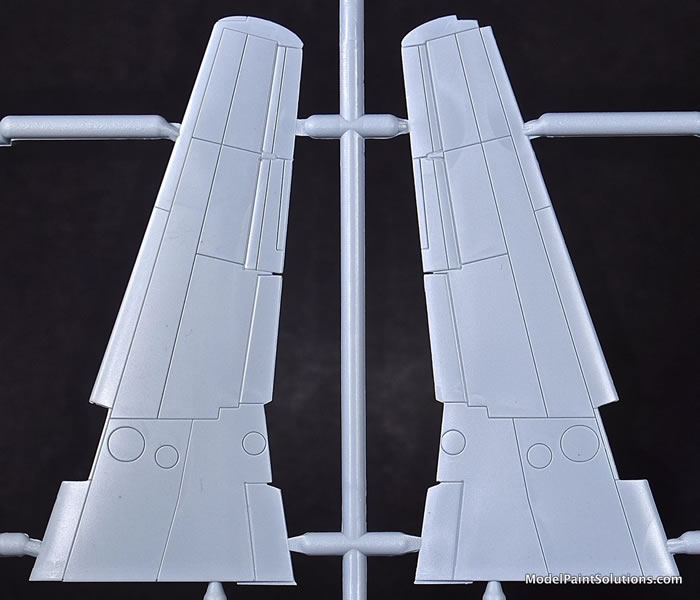
A rather puzzling piece of engineering is the pitot tube assembly, which incorporates both the pitot and the port navigation light. Although easy to assemble, the resulting seams will require filling and dressing which will obliterate the navigation light. This will have to be addressed if you want a more accurate final result.
The landing gear parts are very nicely molded and well detailed. The main gear doors are provided as a single piece (gear up) and as left and right doors (gear down). Although the detail is very nice here, the upper and lower sections of the main gear doors are molded together and the result is on the heavy side.
The canopy parts are crystal clear and nicely molded. The canopy framing is a tad on the heavy side but acceptable. The really good news here is that the canopy is assembled from three separate pieces permitting it to be posed open.
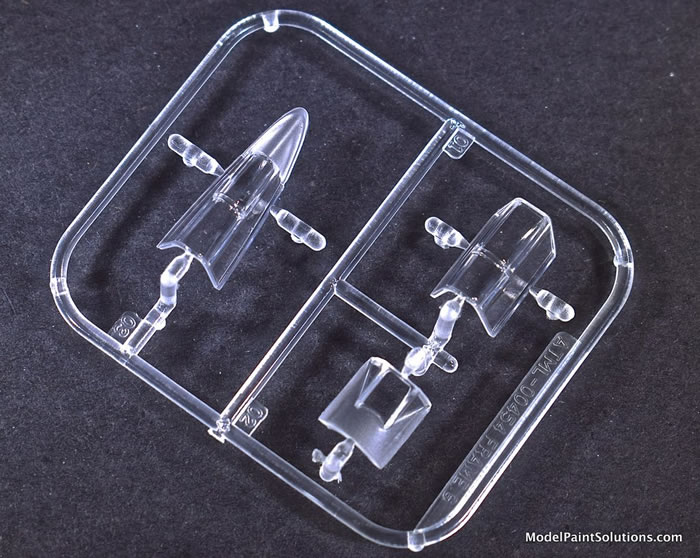
As with their Me-262A, Airfix has used some nice engineering with the front windscreen piece, which incorporates a portion of the upper fuselage decking. This design obviates the nerve-racking step of gluing the rather small front windscreen in place without inducing crazing or smudging of the clear sections.
Markings
The single decal sheet, printed by Airfix, shows good register and scale appropriate colors. A nice set of airframe stencils is provided, as is a colorful and nicely printed, 2-part, instrument panel decal.
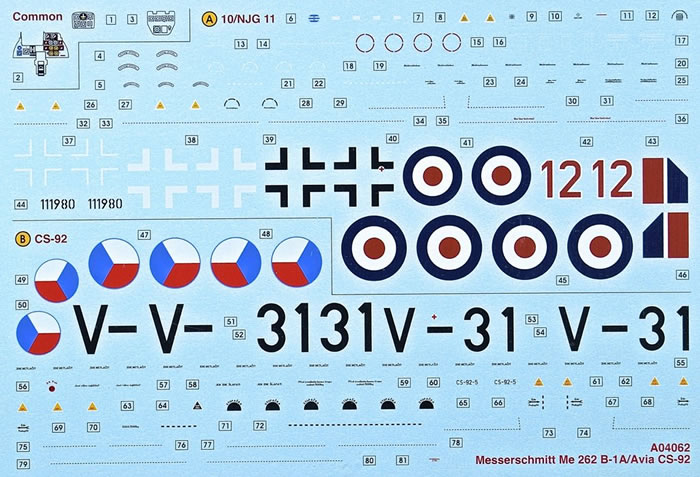
Markings are provided for two rarely covered airframes:
-
Me-262B-1a/U1 Wk.Nr. 111980 “Red12” 10./Nachtjagdgeschwader 11, Schleswig, Germany, May 1945.
-
Avia CS-92 VLU’, Zaetec, Czechoslovakia, September 1947.
The engineering on this kit (excluding the pitot tube) is just great. Although a bit heavy in some areas, the recessed details will look fine under a coat of primer and paint and the two rarely-seen schemes seal the deal: nice kit.
For more on this review and a progressive build of the Airfix Me-262A-1a visit Model Paint Solutions.com
Kit purchased by the reviewer
Review Text and Images Copyright © 2019 by John Miller
Page Created 6 March, 2019
Last updated
6 March, 2019
Back to HyperScale Main Page
Back to Reviews Page

|
Home
| What's New |
Features |
Gallery |
Reviews |
Reference |
Forum |
Search